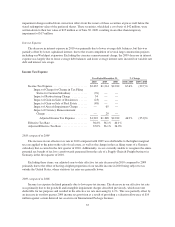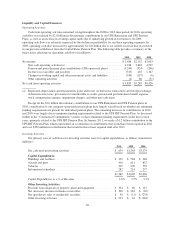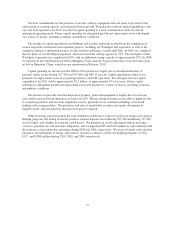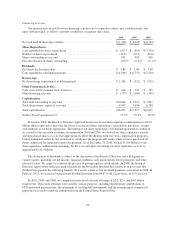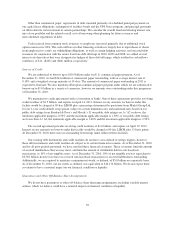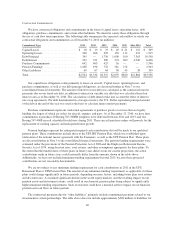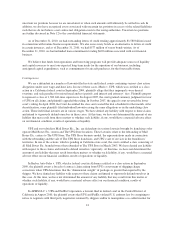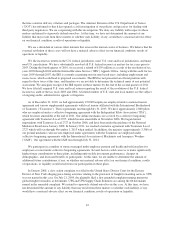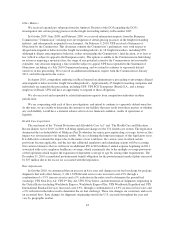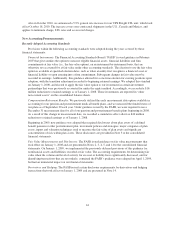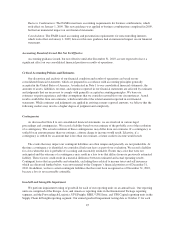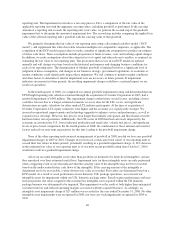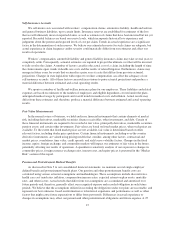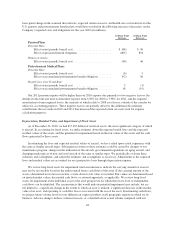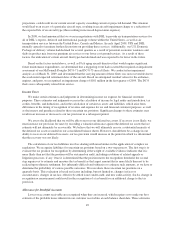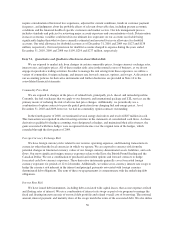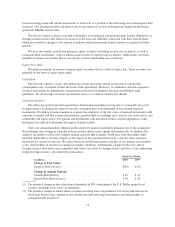UPS 2010 Annual Report Download - page 56
Download and view the complete annual report
Please find page 56 of the 2010 UPS annual report below. You can navigate through the pages in the report by either clicking on the pages listed below, or by using the keyword search tool below to find specific information within the annual report.Also in October 2010, we announced a 5.9% general rate increase for our UPS Freight LTL unit, which took
effect October 18, 2010. The increase covers non-contractual shipments in the U.S., Canada and Mexico, and
applies to minimum charge, LTL rates and accessorial charges.
New Accounting Pronouncements
Recently Adopted Accounting Standards
Provisions within the following accounting standards were adopted during the years covered by these
financial statements:
Financial Instruments: The Financial Accounting Standards Board (“FASB”) issued guidance in February
2007 that gives entities the option to measure eligible financial assets, financial liabilities and firm
commitments at fair value (i.e., the fair value option), on an instrument-by-instrument basis, that are
otherwise not accounted for at fair value under other accounting standards. The election to use the fair value
option is available at specified election dates, such as when an entity first recognizes a financial asset or
financial liability or upon entering into a firm commitment. Subsequent changes in fair value must be
recorded in earnings. Additionally, this guidance allowed for a one-time election for existing positions upon
adoption, with the transition adjustment recorded to beginning retained earnings. We adopted this standard
on January 1, 2008, and elected to apply the fair value option to our investment in certain investment
partnerships that were previously accounted for under the equity method. Accordingly, we recorded a $16
million reduction to retained earnings as of January 1, 2008. These investments are reported in “other
non-current assets” on the consolidated balance sheets.
Compensation-Retirement Benefits: We previously utilized the early measurement date option available in
accounting for our pension and postretirement medical benefit plans, and we measured the funded status of
our plans as of September 30 each year. Under guidance issued by the FASB, we were required to use a
December 31 measurement date for all of our pension and postretirement benefit plans beginning in 2008.
As a result of this change in measurement date, we recorded a cumulative effect after-tax $44 million
reduction to retained earnings as of January 1, 2008.
Beginning in 2009, new guidance was adopted that required disclosures about plan assets of a defined
benefit pension or other postretirement plan, investment policies and strategies, major categories of plan
assets, inputs and valuation techniques used to measure the fair value of plan assets and significant
concentrations of risk within plan assets. These disclosures are provided in Note 5 to the consolidated
financial statements.
Fair Value Measurements and Disclosures: The FASB issued guidance on fair value measurements that
took effect on January 1, 2008 and are presented in Notes 2, 3, 4, 5, and 14 to the consolidated financial
statements. On January 1, 2009, we implemented the previously deferred provisions of this guidance for
nonfinancial assets and liabilities recorded at fair value. The accounting requirements for determining fair
value when the volume and level of activity for an asset or liability have significantly decreased, and for
identifying transactions that are not orderly, contained the FASB’s guidance were adopted on April 1, 2009,
but had an immaterial impact on our financial statements.
Derivatives and Hedging: The FASB issued certain disclosure requirements for derivatives and hedging
transactions that took effect on January 1, 2009 and are presented in Note 14.
44



